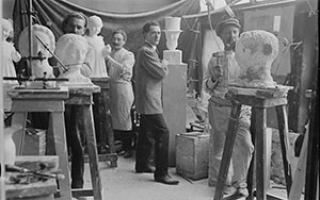Born 1882, Warsaw, Poland
Died 1946, Bronx, New York
Born in occupied Poland, Elie Nadelman began his artistic training in Warsaw before leaving in 1902 to visit Munich, where he developed a passion for early Greek art. In 1905, soon after joining the Polish colony in Paris, he made his debut at the Salon d’Automne. When World War I broke out, Nadelman emigrated to New York with the help of his patron, Helena Rubinstein, and began to introduce genre subjects, such as popular dance, into his repertoire. He married Viola Spiess Flannery in 1919, and together they built the country’s largest collection of folk art, part of which was later documented by the Index of American Design. Consisting of more than 50,000 artifacts, the collection was unique in the US at the time for its inclusion of European objects. In 1926 their Museum of Folk and Peasant Arts opened in Riverdale in the Bronx. After the museum closed in 1937 due to lack of funds, Nadelman stopped exhibiting publicly, although he remained dedicated to his art. He committed suicide in 1946.
Despite his affinity for vernacular subjects, Nadelman was mainly celebrated for the stylized, streamlined grace of his Greek-inspired works. While his classical sculptures garnered an enthusiastic uptown collector base, the plaster genre figures he exhibited downtown beginning in 1917, followed soon by cherrywood and bronze versions, attracted only controversy. Nadelman’s disregard for the boundaries between high and low was also expressed in the organization of his folk art collection, which highlighted formal correspondences across time and space. His passion for folk art later inspired his largely unrealized ambition to produce works for a popular audience. To this end, in the late 1920s he replicated the look of bronze sculpture with more affordable galvano-plastique and made ceramic multiples with individualized touches and inventive patinas.
Dancer (1918) was the only one of Nadelman’s cherrywood vernacular figures to sell during his lifetime. Arranged in a pose reminiscent of Georges Seurat’s Le Chahut (1889–1890), its smooth and simplified wood surfaces are economically defined with a few touches of color. The fleshiness of Nadelman’s glazed ceramic and painted papier-mâché figures of the 1930s represents an increasing transgression of the values that defined his early classical sculptures, then taken further in the palm-sized plaster sculptures he produced beginning in 1938.
Jenevive Nykolak
Haskell, Barbara. Elie Nadelman: Sculptor of Modern Life. New York: The Whitney Museum of American Art, with Harry N. Abrams, Inc., New York, 2003.
Hofer, Margaret K., and Roberta J. M. Olson, eds. Making It Modern: The Folk Art Collection of Elie and Viola Nadelman. New York: New-York Historical Society, with D Giles Ltd., 2015.
